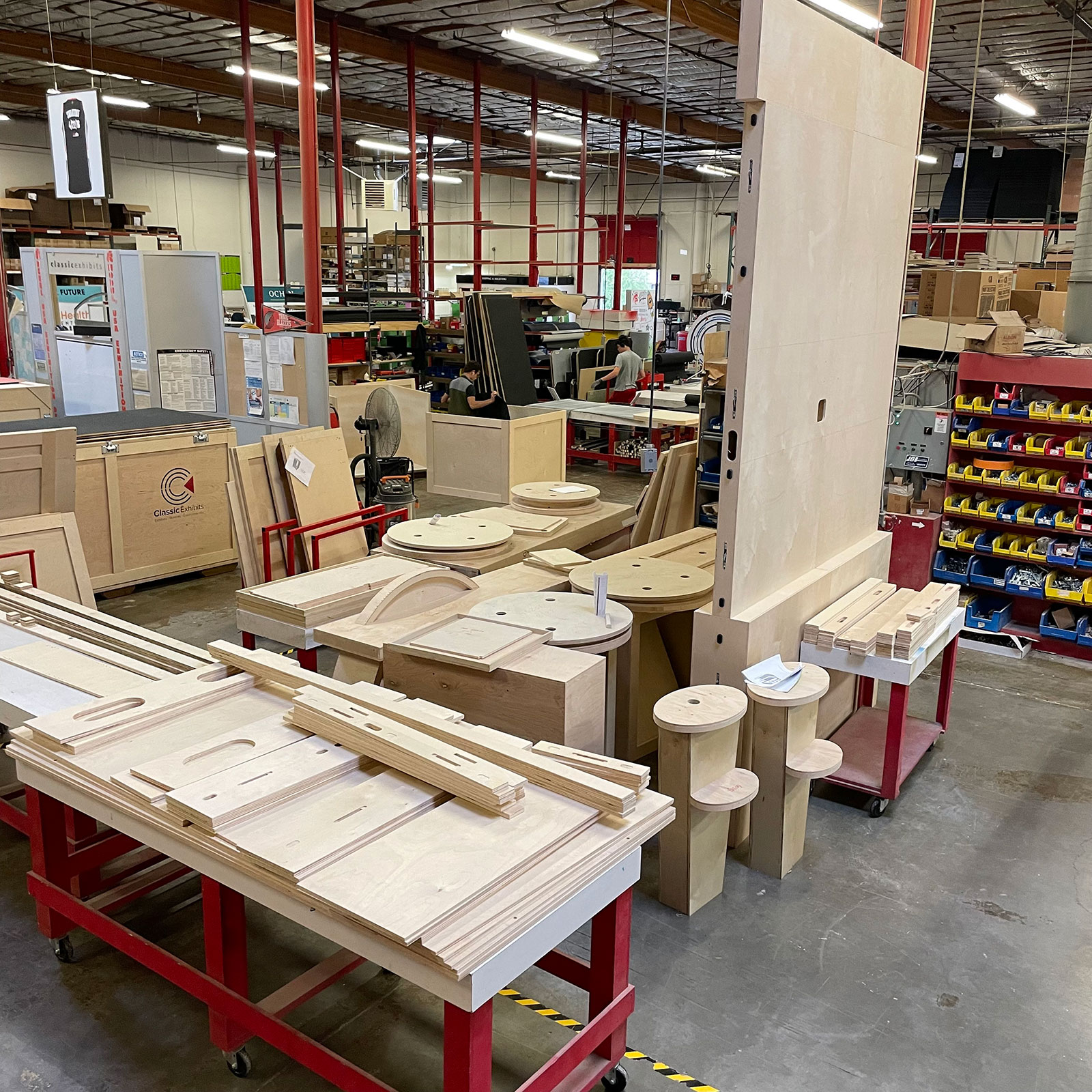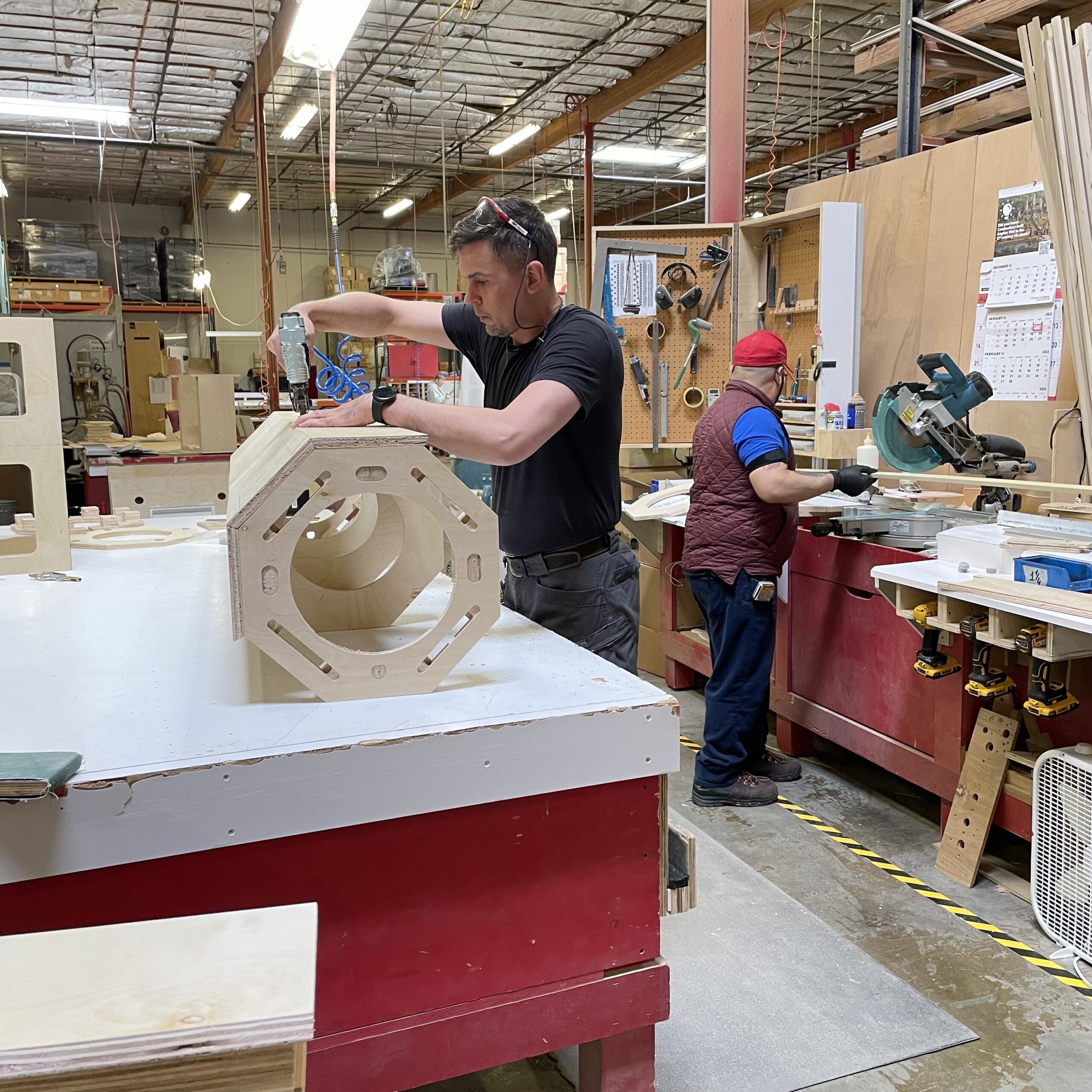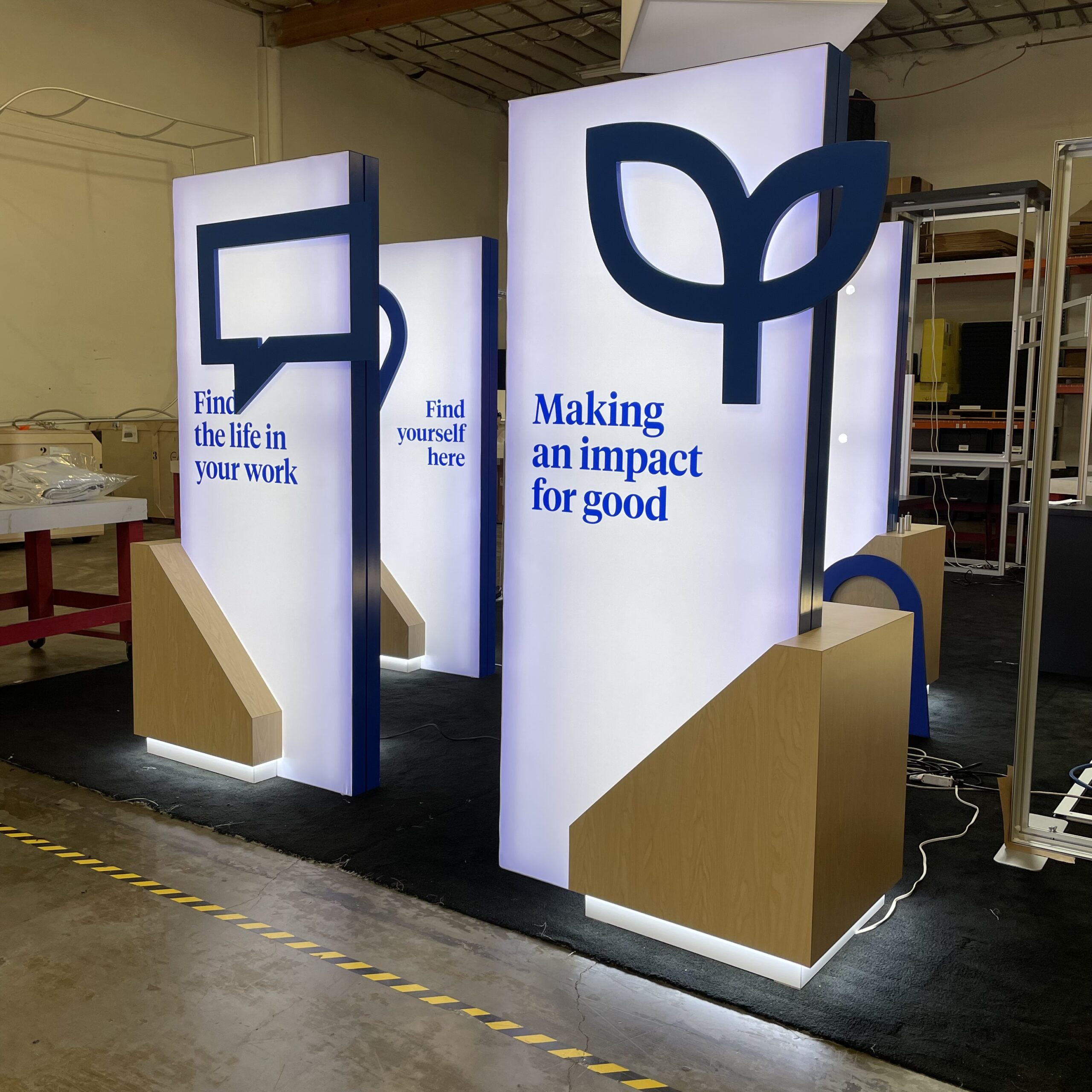Ever wonder what happens “behind the curtain” when an exhibit house builds your display? Join us as we explore this fascinating, highly specialized fabrication process!
Exhibit fabrication, much like set design, relies on custom and modular construction to create displays that appear to be permanent but can be assembled, disassembled, and shipped again and again. And unlike “mass produced” items which rarely vary in function or design, most exhibits are customized to meet the size, design, and marketing requirements of each exhibitor. Sometimes it’s as simple as tweaking an inline or island design. Other times, it’s a completely custom trade show exhibit in every way.
Exhibit fabricators have a few tricks up their sleeves to ensure their clients receive the display they want while doing their best to match their client’s budget. That can be tricky, but tried and true exhibit fabrication techniques are flexible enough to meet the needs of most clients.
An Overview of the Exhibit Fabrication Process
Unlike building a house or an office building, exhibits are temporary structures that must be assembled and disassembled quickly, packed in wood crates or roto-molded cases, shipped securely, and often stored in a warehouse for an extended period of time.
Exhibit fabrication is dictated by the client’s design, marketing goals, and budget. Which can range from a simple tabletop display to a 200 x 250 ft. custom island with several double-deck structures. With enough money and time, anything is possible.
The fabrication capabilities and capacity depend on the size of the exhibit house. However, every custom exhibit house can build most inlines and islands up to a 40 x 60 with the most common display sizes ranging from 10 x 20 to 20 x 40. Exhibit house shop employees include carpenters, metal fabricators, welders, electricians, and general laborers.
In general, the build process, once the design and details have been finalized, requires 4-6 weeks in production. That allows enough time to order materials, laminates, lighting, graphics, and any custom parts from outside suppliers. In most cases, the exhibit will be staged at the facility, including all graphics, to ensure there are no issues. The final assembly instructions will be completed during the staging and packing.
On any given day, It’s not unusual to see multiple exhibits being built at the same time. Or past exhibit builds staged to ensure they’re in good condition before shipping to a show. The production floor at an exhibit house is a hectic place where display construction, assembly, crate construction, and staging are carefully choreographed to ensure every booth conforms to the design requirements and ship date.

From Idea to Blueprint: The Design Phase
Every exhibit project starts long before anyone cuts plywood or bends metal. Account executives and exhibit designers meet with potential clients to listen to their vision and goals. This includes not just the exhibit but also the client’s overall trade show objectives. Exhibit designers, in particular, are skilled at asking questions about the client’s branding, culture, and sales goals.
Perhaps no meetings are more important than these design consultations, which can sometimes be frustrating for both sides. No exhibit designer wants a guessing game, especially when the client is unsure about what they want to achieve at a trade show or how much they’re willing to spend, not just on the exhibit build but on trade show marketing in general. To be fair, many clients are new to trade shows. They don’t have a firm grasp on how much an inline or island exhibit costs, nor have they taken the time to do a deep dive into their marketing objectives (other than “increase sales”).
Design meetings can jumpstart that process, albeit in fits and starts. Experienced trade show exhibitors come to their meetings knowing what did or didn’t work at past shows. In addition, they often share photos of exhibit designs they like. Details feed a great design.
That said, exhibit design is much more than how an exhibit looks. Exhibit designers must take into account show regulations, the overall traffic flow in the booth space, any events, games, demos, or experiential activities in the booth, furniture, meeting, and storage spaces, and the graphics. Remember that trade show exhibits are essentially sales and marketing tools, created to attract attendees and maximize the experience once an attendee enters the booth space. An exhibit designer can’t train your team to greet attendees with a smile or create a memorable demo that “Wows!” potential clients, but they can create the ideal environment for that to happen.
Fabrication Techniques and Materials: Making the Vision Real
Not so long ago, custom exhibits were always wood construction, using fully or partially assembled components. The wood panels connected with camlocks (draw latches) or nuts and bolts. Portable and modular displays were primarily aluminum construction with rollable or direct print graphics.
Today, exhibit fabricators have many more options, which allows them to build distinctive custom exhibits that weigh less and set up faster than ever before. Wood construction hasn’t gone away. In fact, it’s as common as ever, but fabricators are more selective in using wood for unique counters, headers or canopies, charging tables, and accent pieces.
Given a choice, every exhibitor would choose to lower their drayage or material handling bill. Material handling is the fee General Show Contractors (GSC) charge for delivering your exhibit to your show space, storing your crates and cases during the show, and returning them at the end. It’s almost a charge based on the total weight of your exhibit properties. More and more exhibit fabricators are replacing wood panels with modular aluminum frames and tension fabric graphics. Both of which are much lighter than traditional wood construction.
Most custom exhibits are built using the following materials:
- Wood, often birch plywood panels
- Engineered Aluminum Extrusions, including modular aluminum panels
- Fabric Graphics, both backlit and non-backlit
- Direct Print Graphics on foam board
- Vinyl Graphics
- Laminates
- LED Lighting

Bringing it All Together: Trade Show Installation and Dismantle
No one starts the exhibit design and purchase process by exclaiming, “I can’t wait to assemble and disassemble our booth.” No one loves this part unless you purchase IKEA furniture just for the fun of putting it together. And yet, the I&D of a booth can be stress-free or stressful depending on the fabrication, packaging, labeling, and setup instructions.
Here’s a fact that may seem surprising: Most exhibitors want to participate in the booth setup. At some level. However, how much they can assist will depend on the show, the facility, and the size and construction of their exhibit. At some facilities, there are few restrictions. At others, there are strict rules about who can handle lighting, electrical, tools, and ladders. Your exhibit house can guide you through those details, which you’ll want to understand before ordering show services.
Whether you decide to do it yourself, hire labor from the General Show Contractor, or hire an independent Exhibitor-Appointed Contractor (www.eaca.com), there are steps your exhibit house can do to make it easier.
- Setup Instructions: This may sound obvious, but not all booths come with detailed assembly instructions. Sometimes it’s just an exploded view of a 3D drawing. It’s adequate at best and a waste of time and money at worst.
- Labeling and Photos: Modular components are common these days, even for custom exhibits. While some may be the same and are interchangeable. Others merely look the same but have a different purpose or location. The parts and pieces should be labeled and correspond to the setup instructions. Labeling requires more time during the staging and packing but it saves time and money at the show.
- Packing: Is there a logical order to the packing? All too often, the components you need first are packed at the bottom of a crate which requires you to unpack everything in very limited space. Ask your exhibit house to create packing that mirrors the actual assembly and disassembly.
- Packaging: It’s not the same as packing. Packaging refers to how the components are protected in the case or crate. Good packaging gets the booth to the exhibit hall undamaged. Great packaging in the form of reusable and sustainable packaging ensures it can be repacked safely without resorting to disposable foam or bubble wrap. Poor packing and packaging can add hundreds, often thousands of dollars to your exhibit expenses.
Before purchasing any exhibit of any size or at any price, demand to see examples of the instructions and the packaging. Along with the warranty.

Choosing the Right Exhibit Fabrication Company
Let’s be honest. Most exhibit fabricators in North America are good. They wouldn’t have survived multiple economic downturns and the COVID pandemic if they didn’t have solid design and fabrication skills, excellent services, and talented employees. So how do you choose the right one? In general, exhibitors usually choose a builder based on these four factors:
Location: Some exhibitors want their exhibit house to be geographically close to them. They’re in Buffalo, for example, and they want to work with someone local (in Buffalo) or in the region (Upstate NY). Others don’t care. Technology has made distance less important, and other factors weigh more heavily in the decisions.
Capabilities: Not all exhibit houses have the same capabilities. Some have 20 employees. Others have 2000. Some focus exclusively on exhibit design, construction, and storage. Others have event divisions, A/V and digital marketing teams, in-house printing, and onsite supervision services. These same services may be available at a smaller exhibit house but are handled by partners and contractors.
Culture: Every exhibit house has a unique vibe. Just like every company has its own personality. Some people and some companies just click. Along the same lines, exhibit houses often handle specific industries, like medical, government, or food, either by design or by accident. An exhibit house that’s familiar with your industry and your shows makes the overall process easier and allows the creative teams to identify what works and what doesn’t work based on past experience.
Cost: Costs vary. That’s true for any product or service. And the exhibit property is simply one of those costs. It’s important to understand the fees for all the services, which may include exhibit design, project management, storage, graphics, repair and prep services, and shipping. What may seem like a bargain at the front end, may turn into an expensive decision if you feel like you’re getting “nickel and dimed.”

Custom Exhibit Fabrication with Exhibits NW!
Choosing what exhibit fabricator will design and build your next exhibit is important, especially for a custom inline or island exhibit. It should be a partnership, one that evolves as your company and your marketing changes. At Exhibits Northwest, we’ve been designing and fabricating exhibits for more than 20 years. More importantly, we’ve been partnering with companies to elevate their trade show marketing campaigns and guiding them through the hidden landmines of trade shows.
We invite you to contact us for an initial intake meeting and design consultation, and then visit our 125,000 sq. ft. fabrication and printing facility in Portland, OR. We encourage you to browse through the custom section of the www.exhibitsnw.com website to see capabilities and design ideas.
